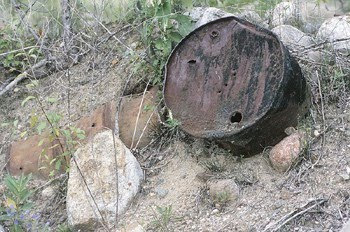LAND POLLUTION
Land pollution is the degradation of the Earth's land surface through misuse of the soil by poor agricultural practices, mineral exploitation, industrial waste dumping, and indiscriminate disposal of urban wastes.
- Soil Misuse
Soil erosion--a result of poor agricultural practices--removes rich humus topsoil developed over many years through vegetative decay and microbial degradation and thus strips the land of valuable nutrients for crop growth. Strip mining for minerals and coal lays waste thousands of acres of land each year, denuding the Earth and subjecting the mined area to widespread erosion problems. The increases in urbanization due to population pressure presents additional soil-erosion problems; sediment loads in nearby streams may increase as much as 500 to 1,000 times over that recorded in nearby undeveloped stretches of stream. Soil erosion not only despoils the Earth for farming and other uses, but also increases the suspended-solids load of the waterway. This increase interferes with the ecological habitat and poses silting problems in navigation channels, inhibiting the commercial use of these waters.
- Solid Waste
- In the United States in 1988 municipal wastes alone--that is, the solid wastes sent by households, business, and municipalities to local landfills and other waste-disposal facilities--equaled 163 million metric tons (1980 million U.S. tons), or 18 k (40lb) per person, according to figures released by the Environmental Protection Agency. Additional solid wastes accumulate from mining, industrial production, and agriculture. Although municipal wastes are the most obvious, the accumulations of other types of wastes are the most obvious, the accumulations of other types of waste are far greater, in many instances are more difficult to dispose of, and present greater environmental hazards.
- The most common and convenient method of disposing of municipal solid wastes is in the sanitary landfill. The open dump, once a common eyesore in towns across the United States, attracted populations of rodents and other pests and often emitted hideous odors; it is now illegal. Sanitary landfills provide better aesthetic control and should be odor-free. Often, however, industrial wastes of unknown content are commingled with domestic wastes. Groundwater infiltration and contamination of water supplies with toxic chemicals have recently led to more active control of landfills and industrial waste disposal. Careful management of sanitary landfills, such as providing for leachate and runoff treatment as well as daily coverage with topsoil, has alleviated most of the problems of open dumping. In many areas, however, space for landfills is running out and alternatives must be found.
- Recycling of materials is practical to some extent for much municipal and some industrial wastes, and a small but growing proportion of solid wastes is being recycled. When wastes are commingled, however, recovery becomes difficult and expensive. New processes of sorting ferrous and nonferrous metals, paper, glass, and plastics have been developed, and many communities with recycling programs now require refuse separation. Crucial issues in recycling are devising better processing methods, inventing new products for the recycled materials, and finding new markets for them.
- Incineration is another method for disposing of solid wastes. Advanced incinerators use solid wastes as fuel, burning quantities of refuse and utilizing the resultant heat to make steam for electricity generation. Wastes must be burned at very high temperatures, and incinerator exhausts must be equipped with sophisticated scrubbers and other devices for removing dioxins and other toxic pollutants. Problems remain, however: incinerator ash contains high ratios of heavy metals, becoming a hazardous waste in itself, and high-efficiency incinerators may discourage the use of recycling and other waste-reduction methods.
- Composting is increasingly used to treat some agricultural wastes, as well as such municipal wastes as leaves and brush. Composting systems can produce usable soil conditioners, or humus, within a few months (see compost).



